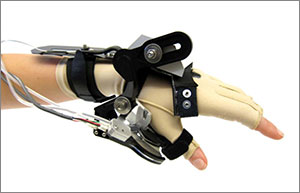
This child-sized device assists children with thumb movements while giving them sensory and visual feedback.
Our ability to use the thumb as an opposable digit is a critical part of what sets us apart as a species. “That’s how you’re holding a pen,” Leia Stirling, PhD, a senior staff engineer at the Wyss Institute for Biologically Inspired Engineering told me recently as we talked about the Wyss’ latest collaboration with Boston Children’s Hospital. “That’s how you hold your phone; that’s how you open a door; that’s what makes us unique.”
It’s also an ability that children who have suffered a stroke or have cerebral palsy or hemiplegia (paralysis on one side of the body) can lose or fail to develop in the first place.
Stirling, along with Hani Sallum, MS, and Annette Correia, OT, in Boston Children’s departments of Physical and Occupational Therapy, are the architects of a robotic device that may improve functional hand use. The device assists children with muscle movements, using small motors called “actuators” placed over the hand joints, while giving them sensory and visual feedback. It’s called the Isolated Orthosis for Thumb Actuation, or IOTA. Full story »

A sequence of motion frames of a normally kicking baby's legs (shown in blue and green), illustrating changing joint angles at the hip and knee.
Countless scientific epiphanies never leave the bench – unless there’s the kind of serendipitous encounter that set Children’s Hospital Boston psychologist Gene Goldfield on a path he never expected to follow.
One in eight babies are born prematurely, putting them at greater risk for cerebral palsy, an inability to fully control their muscles. Goldfield saw these children being wheeled around the hospital, and was convinced that they did not have to be wheelchair-bound.
During early infancy, he knew, the developing brain naturally undergoes a rewiring of its circuits, including those that control the muscles. Could some type of early intervention encourage more typical motor development by replacing damaged circuits with more functional connections?
At Children’s Innovators’ Forum last week, Goldfield discussed his envisioned solution: the use of programmable robots Full story »
The seemingly random flailing of a newborn’s arms and legs is more important than it looks – it’s how babies begin to explore the physical world and their place in it. This motion-capture movie shows the normal kicking of a 5-month-old, but when a baby’s muscles are weakened by brain injury, this exploration is curtailed. It becomes a vicious cycle: the motor parts of the brain can’t develop properly, impairing mobility even further. Psychologist Eugene Goldfield, PhD, of the Center for Behavioral Science at Children’s Hospital Boston, with a team of engineers and scientists at the Wyss Institute, is in the early stages of a project that could help break this cycle for babies with cerebral palsy.
Goldfield calls it the “second skin” – smart clothing whose fabric, studded with tiny sensors, would pick up attempts at motion. Full story »
Infant kicking data being captured for the "second skin"
Two or three years ago, seeing all the children in wheelchairs coming to Children’s Hospital, I asked myself whether I might be able to contribute something tangible to help restore their mobility. A psychologist by training, I had published some academic articles on how young children become independently mobile. But I’ve also always liked to build things.
It became clear that anything I wanted to build would require skills I didn’t have. I envisioned a form-fitting, electronic garment that a child with a brain injury could wear to assist his or her biological muscles, teaching the brain how the body should move. How on earth could I get the money to build such a garment, and who could help me? Full story »









